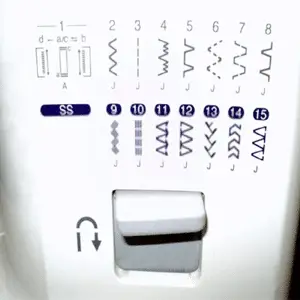You always have a ton of options when it comes to buying your first sewing machine. You could go for the most expensive one, or you might want something more affordable and basic that will get the job done with time.
There are so many considerations to make before settling on one! What do I need? How much am I willing to spend? Do they even sell these in my country at all?! If you’re looking for help deciding which is best suited for your needs, check out our list below:
Things To Look Before Buying A Sewing Machine
1. Basics
Your creativity is the limit!
If you want a machine that lasts, look for one with an axial rotary hook rather than a full-rotation metal hook. The latter will avoid jams and lint build-up but may cost more over time because it needs to be serviced often.
A good way to reduce maintenance costs is by getting an all-plastic sewing machine that never clogs or builds up uneven stitches like metal can do after being used frequently as well as heavy use from thick fabrics such as denim jeans and polar fleece sweaters – this also means fewer repairs in the long run too!
If you purchase a machine, make sure it has an automatic pressure adjustment. This will keep the machine from jamming with thicker materials and having to change settings manually.
2. Stitch Options
The straight stitch is the most common and will be used often, although a zigzag should also be in your repertoire to finish raw edges.
The stretch straight can come into play when you need something that needs more security than the other two stitches after lots of wear – it’s an advanced technique best left for machines with precision capabilities.

If you want to create hems that are not visible on one side or barely seen from either side without needing any additional sewing steps like clipping corners then this blind hemmer is perfect!
Finally, buttonholes have traditionally been considered complicated since they involve multiple steps but innovative technology has taken care of that so now we only require one step if desired!
3. Mechanical or Electronic
There are two types of sewing machines: mechanical and electronic.
A mechanical machine needs you to turn dials to get the stitches that you want, but an electronic one automatically adjusts for those adjustments by sensing what type of stitch it is so all you have to do is just press a button!
The solid-state ones also allow multiple threads at once as well as heavier materials such as leather or denim canvas which makes them more expensive than their counterparts.
4. Bells and Whistles
It is important to get the right tools for your needs. Some machines can have features added down the line so it’s best you find out if that option will be available in case there are skills you want to learn which would require those extra features at a later date.
5. The Weight and Size of the Machine
There are many factors when deciding which sewing machine to buy, but for those who need a portable option or plan on using their machines at home occasionally and not all the time then the weight is an important factor.
If you’ll be taking your machine with you often such as for craft fairs, etc., it’s best to see if it’s lightweight enough before buying since there can even be differences in weights between different models of smaller size sewing machines that require less power than larger ones do
This may seem like a minor consideration when looking into purchasing new equipment – especially given how much heavier older-style fabric cutting wheels were compared to newer electric versions – but more modern laptops have shown us just what happens if we ignore this issue: hardware failure from carrying our
6. Budget
When you are deciding which machine is best for your needs, the cost may be a major consideration. There are some great machines available at very affordable prices and they can provide years of service without upgrading or replacing them.
When buying your first sewing machine, it is important to be sure you are getting enough without overbuying.
You want something that will last a while and not need repairs often if this new hobby turns out to just be for novelty purposes or only done in the evenings once every few weeks with friends who don’t sew themselves.
I recommend looking at machines on the lower end of the spectrum – think $200-300 range as these can withstand more wear and tear than those valued higher because they have cheaper parts made from plastic instead of metal like others do.
7. Service and Warranty
When choosing a new sewing machine, you should ask the company about its warranty and what it covers. You can also ask if the service is available locally or will have to be mailed somewhere else.
If possible, talk with other sewers who are experienced in using this type of equipment for any advice they may offer on customer service from that particular brand.
It’s always important to do your research before making such an expensive purchase!
Some Last Words
It’s important to research the features of each machine before purchasing. Remember, quality is more important than added features so make sure your new purchase will be dependable and last a long time.
A good sewing machine is one of the most important tools for a seamstress. Hope the above guide about things to look for before buying a sewing machine will help you in finding the right sewing machine.
Check Out These Posts Too!
Good Luck!!!

Robert Patricia
Robert Patricia is a data analytic and content creator. He has worked extensively with large data sets to glean insights for both public and private sector clients. He has used this knowledge to create compelling content for brands across the internet. Albert also enjoys creating content for websites and social media. He is an expert at creating catchy headlines and understands how to capture the attention of readers.
